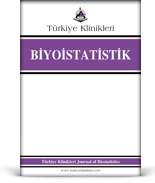Amaç: Bu çalışmada, parametrik istatistiksel yöntemlerin doğru ve güvenilir sonuçlar verebilmesi için temel varsayımlardan biri olan normal dağılım koşulunun sağlanması incelenmiştir. Normal dağılım varsayımını karşılamayan verilerde, bu koşulu sağlamak amacıyla veri dönüşümüne ihtiyaç duyulmuştur. Bu bağlamda, verilerin dağılım yapısını normal dağılıma yaklaştırmak ve istatistiksel analizlerin güvenilirliğini artırmak için Box-Cox dönüşüm yöntemi uygulanmıştır. Gereç ve Yöntemler: Gamma dağılımına sahip, 3 farklı rastgele veri seti üretilmiştir. Bu veriler, normal dağılım varsayımını karşılamadığında, parametrik testlerin temel koşullarını sağlamak amacıyla Box-Cox dönüşüm yöntemi uygulanmış ve dönüşüm parametresi olan λ değerleri maksimum log-olabilirlik yöntemiyle belirlenmiştir. Bulgular: Gamma dağılımı kullanılarak elde edilen 3 farklı veri seti, normal dağılım varsayımını sağlamamış ve sağa çarpık bir yapı sergilemiştir. Bu veri setlerinde çarpıklık düzeyleri sırasıyla şiddetli, orta ve hafif olarak gözlemlenmiştir. Verilerin normal dağılıma yaklaştırılması amacıyla Box-Cox dönüşüm yöntemi uygulanmış ve her bir veri seti için dönüşüm parametresi olan λ (lambda) değerleri belirlenmiştir (sırasıyla 0,262; 0,343 ve 0,262). Dönüşüm sonrasında yapılan analizler, tüm veri setlerinin normal dağılım varsayımını sağladığını göstermiştir. Sonuç: Box-Cox dönüşümü, özellikle pozitif ve sürekli verilerde çarpıklığı azaltmak için kullanılan etkili bir yöntemdir. Bu dönüşüm sayesinde veriler daha simetrik hâle gelir ve normal dağılıma daha uygun bir yapı kazanır. Bu nedenle çeşitli veri setlerinde gözlemlenen çarpıklığın etkin şekilde giderilmesi ve normal dağılım varsayımının sağlanmasında önemli bir yöntemdir.
Anahtar Kelimeler: Box-Cox dönüşümü; gamma dağılımı; λ parametresi
Objective: This study investigates the fulfillment of the normality assumption, a fundamental prerequisite for the validity and reliability of parametric statistical methods. In cases where data do not satisfy this assumption, data transformation becomes necessary to achieve normality. In this context, the Box-Cox transformation method was applied to approximate the distribution structure of the data to a normal distribution and to increase the reliability of the statistical analyses. Material and Methods: Three different random data sets following a gamma distribution were generated. Since these data sets did not meet the normality assumption, the Box-Cox transformation method was applied to satisfy the fundamental requirements of parametric tests. The transformation parameter λ was estimated using the maximum log-likelihood method. Results: Three distinct data sets generated using the gamma distribution did not satisfy the normality assumption and exhibited right-skewed distributions. The levels of Skewness in these data sets were observed to be severe, moderate, and mild, respectively. To bring the distributions closer to normality, the Box-Cox transformation method was applied, and the transformation parameter λ (lambda) was estimated for each data set (0.262, 0.343, and 0.262, respectively). Subsequent analyses demonstrated that, following the transformation, all data sets met the normality assumption. Conclusion: The Box-Cox transformation is an effective method used primarily to reduce Skewness in positive and continuous data. This transformation helps make the data more symmetric and better conform to a normal distribution. Therefore, it is an important technique for effectively correcting Skewness observed in various datasets and ensuring the assumption of normality is met.
Keywords: Box-Cox transformation; gamma distribution; λ parameter
- Weibull W. A statistical distribution function of wide applicability. Journal of Applied Mechanics. 1951;18(3):293-7. [Crossref]
- Lawless JF. Statistical Models and Methods for Lifetime Data. 2nd ed. New York: John Wiley&Sons; 2003.
- Hahn GJ, Shapiro SS. Statistical Models in Engineering. 1st ed. New York: John Wiley&Sons. 1967.
- Birnbaum ZW, Saunders SC. A statistical model of life length of materials. Journal of the American Statistical Association. 1958;53(281):151-60. [Crossref]
- Lee ET, Wang JW. Statistical Methods for Survival Data Analysis. 3rd ed. New York: John Wiley&Sons, Inc; 2003. [Crossref] [PubMed]
- Alpar R. Uygulamalı İstatistik ve Geçerlilik-Güvenirlik. 6. Baskı. Ankara: Detay Publishing; 2020.
- Box GEP, Cox DR. An analysis of transformations. Journal of the Royal Statistical Society. Series B (Methodological). 1964;26(2):211-43. [Crossref]
- Gillard J. A generalised Box-Cox transformation for the parametric estimation of clinical reference intervals. Journal of Applied Statistics. 2012;39(10):2231-45. [Crossref]
- Sun L, Tong X, Zhou X. A class of Box-Cox transformation models for recurrent event data. Lifetime Data Anal. 2011;17(2):280-301. [Crossref] [PubMed]
- Rahman M. Estimating the Box-Cox transformation via Shapiro-Wilk W statistic. Communications in Statistics-Simulation and Computation. 1999;28(1):223-41. [Crossref]
- Rahman M, Pearson LM. Anderson-Darling statistic in estimating the Box-Cox transformation parameter. Journal of Applied Probability & Statistics. 2008;3(1):45-57. [Link]
- Dag O, Asar O, Ilk O. A methodology to implement Box-Cox transformation when no covariate is available. Communications in Statistics-Simulation and Computation. 2014;43(7):1749-59. [Crossref]
- Shapiro SS, Chen L. Composite tests for the gamma distribution. Journal of Quality Technology. 2001;33(1):47-59. [Crossref]
- Yüzer AF. Olasılık ve İstatistik. 1. Baskı. Eskişehir: Anadolu Üniversitesi Fen Fakültesi Yayınları; 1996.
- Asar Ö, Ilk O, Dag O. Estimating Box-Cox power transformation parameter via goodness-of-fit tests. Communications in Statistics-Simulation and Computation. 2017;46(1):91-105. [Crossref]
- Grimett, GR, Stirzaker DR. Probability and Random Processes. 3rd ed. United Kingdom: Oxford University Press; 2001. [Crossref]
- Saralees N. Some gamma distributions, statistics. A Journal of Theoretical and Applied Statistics. 2008;42:1:77-94. [Crossref]
- Das SC. Fitting truncated Type III curves to rainfall data. Australian Journal of Physics. 1955;8:298-304. [Crossref]
- Stephenson DB, Kumar KR, Doblas-Reyes FJ, Chauvin E, Pezzulli S. Extreme daily rainfall events and their impact on Ensemble Forecast of the Indian Moonsoon. Monthly Weather Review. 1999;127(9):1954-66. [Crossref]







.: İşlem Listesi